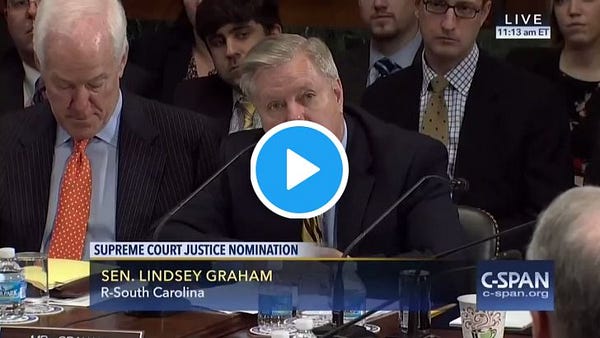
This is of those moments.
You’re going to remember where were you when you heard the news that Justice Ruth Bader Ginsberg died just 45 days before the election. (Read Kim Wehle’s tribute to RBG here.)
Just when we thought 2020 couldn’t possibly get worse, we are about to see one of the ugliest political fights of our lifetime. It will leave scars not just on our politics, but also on the culture, and the legitimacy of the Court itself.
If you’ve been working on your ‘Worst Case Scenarios,” you’re going to have tear up and start over. If you’ve been playing at home, it’s possible that your 2020 Apocalypse Bingo card is nearly filled up.
The court vacancy obviously has long term consequences for abortion, voting rights, the environment, immigration, and the next generation of jurisprudence. But TrumpWorld is already gaming out the implications of 4-4 or 5-3 split in a contested election this year. All the planets and meteors of death are coming into alignment.
Of course, the coming bloodbath could be avoided if calmer, reasonable heads prevailed. But who are we kidding? This is 2020 and these fights always seem to bring out of very worst. Here’s a (since deleted) tweet from a prominent Catholic “intellectual.”

And here is GOP congressman and Georgia senate candidate Doug Collins keeping it classy:

So what happens now?
There was a time when our leaders would try to avoid a fight that would tear the country apart, shatter constitutional norms, and permanently damage the image of the Supreme Court. But you know that this is not that time.
The Trump White house immediately leaked plans to name a successor within days, and Senate Majority Leader Mitch McConnell barely waited an hour before putting out a statement reaffirming his intention to ignore RBG’s dying wish and bring it to a vote — either before the election or in a lame duck session. It’s not yet clear that he has to votes. (It will take four GOP defections to block a nominee.)
Either way, the pressure will be intense to ram through a new justice, who would solidify conservative dominance of the court for years.
We’ll have to wait for some polling to get a firmer idea how this changes the presidential race. But my initial reaction was:

The smart play here would be for Trump to announce who he would choose if he was re-elected, and so make the election into a referendum on the Supreme Court. The visceral/red meat play would be to immediately shift to ramming speed. Is there any doubt which option Trump will choose?
The honest answer is that nobody knows how this will change the dynamics of the election. But we just got our pre-October surprise. (We’ll be doing a special Saturday Bulwark podcast on this… so make sure you keep an eye out.)
In this morning’s Bulwark, JVL has a masterful piece laying out the options and the political crises they could spark. Trump and the GOP now have three choices:
(1) Will he and the Republican Senate attempt to ram a replacement for Ginsburg through the Senate before voters render a verdict on them?
(2) Will he wait until after the election, but before January 20, to replace Ginsburg?
(3) Or will he abide by the same rationales that were deployed in the case of Merrick Garland, and allow the next president and Senate to attend to this matter?
It is not clear that any of these pathways leads to a good outcome for the country. This may be—forgive the mixed metaphor—the black swan that breaks America’s back.
Each one of those options carries massive risks, both short term and long term. But, as JVL writes, the bottom-line is this: “If Trump and Republicans replace Ginsburg it will destroy the remaining public legitimacy of the Supreme Court. Full stop.”
The Republican party’s willingness to invent, bend, cherry-pick, or break rules and norms as needed in the pursuit of power would be undeniable. Already Republican activists have begun creating ludicrous, tortured rationales: Since 1880, no Senate with more than three left-handed members has failed to vote on the nominee of a president whose name contains the letter “d.” To anyone with ears to hear and eyes to see, these justifications are an affront to common sense and basic fairness.
If Republicans choose this route, their ruthlessness would have resulted in not one, but two SCOTUS seats that will be widely regarded as stolen. And worse: stolen by a president who was himself elected despite a decisive loss in the popular vote.
Imagine what would happen if Ginsburg were replaced before November, and then Joe Biden wins the presidency and Democrats capture the Senate. There would be enormous pressure to somehow reform the Supreme Court. And it is not clear what principled counterargument might be mounted against such ideas, even if the “reform” proposals amount to enlarging and packing the Court.
The Supreme Court has become increasingly politicized since the failed nomination of Robert Bork in 1987. But it still retains a great deal of independence and popular legitimacy. This is largely a testament to the character of the justices, which has mostly outbalanced the cravenness of the politicians who have appointed and confirmed them.
But this politicization will be as nothing—absolutely nothing—compared to what would happen if Ginsburg is replaced before November 3.
But, Last argues that the alternative — pushing through a new justice during the lame duck session — would be even worse.
If Trump and Senate Republicans are defeated in the election, but then try to replace Ginsburg before leaving office, the political retribution would be incalculable. The Democratic party would believe—with good reason—that there are no limits to majoritarian rule.
At which point, the powder keg would explode.
As JVL notes, “Trump’s white nationalist base is already demanding that the president fill Ginsburg’s seat immediately.”
As usual, Trump will be very reluctant to buck his base on this. But there is a way out.
The conservative legal establishment could announce its preference to leave the seat vacant, thus taking out of play most potential nominees—and also giving cover to elected Republicans to agree that the decision should wait.
If the Federalist Society declines to defuse this bomb, then Mitch McConnell could do so by simply announcing that what was good for the goose is good for the gander, and that his caucus will not entertain a nominee. (More on this in a moment.)
If McConnell declines this path, then a small group of Republican senators could prospectively announce that they will join with Democrats to block any nomination. This would be risky, both because it would tempt Trump and Senate Republicans to call their bluff and force them to actually make the vote, and because it would free both Trump and other Republicans to demagogue the issue and preemptively delegitimize any justice not appointed by Trump.
Read the whole thing in today’s Bulwark.
Cue the Hypocrisy Olympics.
The fate of the Court fight will be decided by four GOP senators. That’s the number it will take to deprive Trump and McConnell of the majority they would need to drive a new nominee through.
A bunch of senators — including Lindsey Graham, Susan Collins, Chuck Grassley, and Lisa Murkoski — have suggested they would oppose a rushed pre-election vote. Presumably, Mitt Romney would join them.
But…
Over the last four years we’ve learned that principles are for cucks. We’ve gotten used to watching politicians reverse long-held positions, or perform gymnastic flipflops to accommodate His Orangeness. So don’t expect this to be an episode that breaks the mold.
Even so, the soundbites are worth sharing. Here’s Graham from 2018:




There’s a lot like that out there:
Sen. Thom Tillis (R-N.C.)
Late in 2016, Tillis wrote an op-ed defending the GOP’s decision to refuse a hearing for Garland, saying “voters — not a lame-duck president — should decide the composition of the highest court in the land.”
Sen. Cory Gardner (R-Colo.), Gardner, who faces a tough reelection battle in a state Hillary Clinton won in 2016, defended the GOP’s decision to deny Garland a hearing.
“The next president of the United States should have the opportunity to fill the vacancy on the Supreme Court,” Gardner said at the time. “In 1992, even then-Senator Joe Biden stated the Senate should not hold confirmation hearings for a Supreme Court nominee until after that year’s presidential election. Our next election is too soon and the stakes are too high; the American people deserve a role in this process as the next Supreme Court Justice will influence the direction of this country for years to come.”
Keep an eye on Kelly.
One wildcard here: (Via the NYT) “The winner of the Arizona Senate race could be seated in time for a vote on a Supreme Court pick..”
If Mark Kelly, the Democratic nominee for Senate in Arizona, unseats Senator Martha McSally, a Republican who was appointed to her seat and began serving last year, he could be sworn in as early as Nov. 30 — possibly in time to vote on a new Supreme Court nominee, elections experts said.
Hypothetically, that would narrow the Republicans’ 53-to-47 majority in the upper chamber, which may become relevant if a vote on a replacement for Justice Ruth Bader Ginsburg was delayed until a lame-duck session after the election.
How About Something Completely Different?
I’ve been trying to capture the strangeness of this time, but, as it turns out, my novelist wife has done a much better job tham I ever could.
It was the most beautiful summer I can remember here. Day after golden day unfolded in rich, scented glory. The sun, the heat, the lushness of the woods and garden, the perfect refreshment of the lake were everything anyone could wish for. But it was an odd summer, too: no picnics with friends, no Memorial Day, no parties at the lake, no baseball in May and June, no Fourth of July, no parade, no fireworks, no farmers market, no family reunion, no Labor Day end of summer celebrations. There were no markers, no points in time. Just the silent turning of the earth, the move toward the sun and then away from it, the days turning, too, from morning to afternoon to evening. The light lengthening, the light retreating. The restless sleep. Then morning again.
It’s difficult to explain the dreamy quality of life these days. I tell myself it should be a time of joy and productivity, but somehow it isn’t. It’s not a happy dreaminess—I don’t know how it could be—but it’s not unhappy, either. It’s a sense of unreality; as if time is over.
You can read the rest on her blog.




